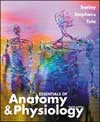 |  Essentials of Anatomy & Physiology, 4/e Rod R. Seeley,
Idaho State University
Philip Tate,
Phoenix College
Trent D. Stephens,
Idaho State University
Development, Heredity, and Aging
Study OutlinePrenatal Development
Clinical age v. developmental age
Fertilization and early cell divisions(Fig. 20.1, p. 552)Blastocyst(Fig. 20.2, p. 553)Implantation and development of the placenta(Fig. 20.3, p. 553)Chorion and placenta
Hormone production(Fig. 20.4, p. 554) Embryonic attachment to placenta(Fig. 20.5, p. 555)
Clinical Focus: Embryo Transfer p. 554 Formation of germ layers(Fig. 20.6, p. 557, Tbl, 20.1, p. 556)Amniotic cavity and amniotic fluid
Primitive streak formation
Embryonic disk
Ectoderm
Endoderm
Mesoderm
Neural tube and neural crest formation(Fig. 20.7, p. 557)Formation of general body structure(Fig. 20.8, p. 557)Limb buds
Development of the face(Fig. 20.9, p. 558) Development of organ systems(Table 20.2, p. 560-561)Digestive tract(Fig. 20.10, p. 559)Outpocketings of GI tract(Fig. 20.11, p. 559)Heart(Fig. 20.12, p. 560) Growth of the fetus(Fig. 20.13, p. 563) Parturition(Fig. 20.14, p. 564)Stages of labor
First stage
Second stage
Third stage
Factors influencing the process of parturition(Fig. 20.15, p. 565) The Newborn
Respiratory and circulatory changes
At the time of birth(Fig. 20.16a, p. 566)after birth(Fig. 20.16b, p. 567) Digestive changes
Lactation
Events of mild let-down(Fig. 20.17, p. 569)Colostrum
First Year Following Birth
Life Stages (Developmental Age)Germinal period - fertilization to 14 days
Embryo -14 to 56 days
Fetus -56 days to birth
Neonate -birth to 1 month
Infant -1 month to walking
Child -walking to puberty
Adolescent -puberty to 20 yrs.
Adult -20 years to death
Young adult -20 to 40 yrs.
Middle age -40 to 65 yrs.
Older adult -65 + yrs.
Aging
Changes
Causes
Death
Causes
Definition
Genetics Clinical Focus: The Human Genome Project p. 576
Chromosomes
DNA
Somatic cells v. sex cells
Karyotypes(Fig. 20.18, p. 572)Autosomal chromosomes
Sex chromosomes
Sex determination(Fig. 20.19, p. 572)Meiosis-homologous pairs
Genes
Alleles
Heterozygous and homozygous
Linked genes
Crossing-over
Dominant and recessive inheritance(Fig. 20.20, p 574)Genotype and phenotype
Carriers of recessive genes
Dominant and recessive
Genotype and phenotype
Sex-chromosome linked traits(Fig. 20.21, p. 574)Other patterns of gene expression
Incomplete dominance
Codominance
Polygenic traits(Fig. 20.22, p. 575) Genetic Disorders
Mutations
Oncogenes and cancer
Tumor suppressor genes
Carcinogens
Genetic susceptibility
Genetic counseling
Pedigree(Fig. 20.23, p. 575)Karyotyping
Other testing
|
|



 2002 McGraw-Hill Higher Education
2002 McGraw-Hill Higher Education